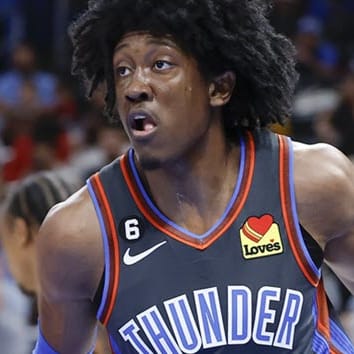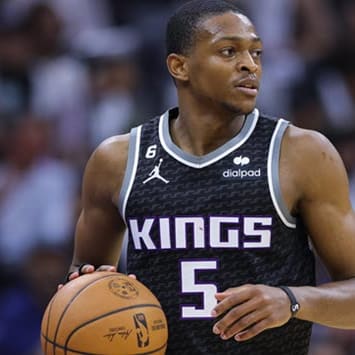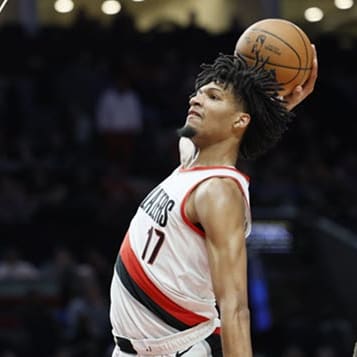This article is part of our NBA Injury Analysis series.
RotoWire's Jeff Stotts takes a look at the most impactful early-season injuries from an athletic trainer's perspective.
Nicolas Batum
The Hornets forward is currently recovering from an elbow sprain suffered in the preseason. Batum tore the ulnar collateral ligament (UCL) in his left elbow and was initially expected to miss eight-to-12 weeks. UCL tears have become a recurring issue in fantasy baseball as many MLB pitchers have undergone Tommy John surgery, the procedure utilized to reconstruct the ligament. However, UCL tears are relatively uncommon in basketball.
The UCL's primary role is to stabilize the medial (inside) aspect of the elbow. While the area is subjected to high level of stress during the overhead throwing motion, basketball player rarely overload this area. Case in points, Batum's injury is just the seventh confirmed moderate UCL injury in the last 13 seasons. The average number of missed games for these cases is roughly 21 games (6-to-7 weeks) but that includes several players that suffered partial tears. Fortunately, Batum's injury will not require surgery and will not cost him the entire season. Look for Charlotte to welcome him back sometime in late-November to early December.
Kawhi Leonard
The former Finals MVP has yet to suit up for the Spurs as he recovers from a quadriceps tendinopathy. The terminology for these types of injuries can be a bit misleading and convoluted but let's try to navigate through them anyway.
Tendinitis is classified as an acute injury when a tendon becomes irritated and inflamed. Tendinitis is
RotoWire's Jeff Stotts takes a look at the most impactful early-season injuries from an athletic trainer's perspective.
Nicolas Batum
The Hornets forward is currently recovering from an elbow sprain suffered in the preseason. Batum tore the ulnar collateral ligament (UCL) in his left elbow and was initially expected to miss eight-to-12 weeks. UCL tears have become a recurring issue in fantasy baseball as many MLB pitchers have undergone Tommy John surgery, the procedure utilized to reconstruct the ligament. However, UCL tears are relatively uncommon in basketball.
The UCL's primary role is to stabilize the medial (inside) aspect of the elbow. While the area is subjected to high level of stress during the overhead throwing motion, basketball player rarely overload this area. Case in points, Batum's injury is just the seventh confirmed moderate UCL injury in the last 13 seasons. The average number of missed games for these cases is roughly 21 games (6-to-7 weeks) but that includes several players that suffered partial tears. Fortunately, Batum's injury will not require surgery and will not cost him the entire season. Look for Charlotte to welcome him back sometime in late-November to early December.
Kawhi Leonard
The former Finals MVP has yet to suit up for the Spurs as he recovers from a quadriceps tendinopathy. The terminology for these types of injuries can be a bit misleading and convoluted but let's try to navigate through them anyway.
Tendinitis is classified as an acute injury when a tendon becomes irritated and inflamed. Tendinitis is often manageable with various types of treatment and players can often learn to play with the condition. Types of tendinitis include patellar tendinitis, quadriceps tendinitis, and Achilles tendinitis.
The term tendinosis is used when the injury is classified as a chronic issue and is generally considered more significant. Tendinosis occurs when a tendon has been damaged and fails to completely heal. The condition is often very painful and the tendon is left functionally limited.
Either one of these problems can be listed as a tendinopathy. The tendinopathy classification is utilized to indicate a disorder of the tendon and is often used as a catch-all term. As a result, it is difficult to determine exactly what Leonard is currently dealing with. However, it should be noted the Spurs forward missed time last year with a quadriceps injury on the same leg, suggesting this has been on-going problem.
Leonard has progressed in his recovery but continues to receive treatment on the area and remains without a definitive timeline. Fantasy owners desperate for Leonard's return should take a bit of solace in knowing the Spurs have the NBA's top-rated medical staff. Working with this talented group should allow Leonard to not only get back to playing but remain on the court upon his return.
Gordon Hayward
Hayward's gruesome injury took the shine off Opening Night and set back a talented Boston team. Hayward suffered a dislocated ankle and fractured tibia six minutes into the game and is not expected to return this season.
Initial comparison to Paul George's traumatic leg injury are normal but the two injuries are drastically different. George's injury was an open fracture of both the tibia and the fibula. While a surgical rod was needed to stabilize the fracture site, George's injury actually occurred in a favorable location. By breaking the bones near the mid-shaft, George avoided extensive ligament and tendon damage.
However, Hayward wasn't quite as fortunate. His break occurred at the distal end of the tibia, a site that serves as an anchor site for multiple ligaments. These ligaments were further comprised with the forced dislocation. According to a statement released by the Celtics, Hayward's surgery included "bony and ligamentous stabilization." The procedure likely involved surgical screws and a plate and not a rod like George.
The magnitude of the injury will require a complex rehabilitation but Hayward is surrounded by a solid medical team that will help him navigate the process. His recovery will be well covered over the next year and it seems likely he will be ready for the start of next season.
Chris Paul
The Rockets have had CP3 in uniform for just one game due to a left knee injury. The injury is being described as a contusion though, like most of the situations discussed here, can be misleading.
Most people associate the term contusion with soft tissue bruise. However, the term can be used to describe a more serious bone contusion or bone bruise. Bone contusions generally take longer to heal than soft tissue contusions. This is because healing factors within the body repair the associated damage just as it would for a true bone fracture. New bone tissue must be laid down to fill in the gaps created during the injury. Furthermore, bone bruises in the knee often require even more time due to the biomechanics of the joint.
Houston expects his recovery to take weeks not days and have been actively looking at other options at point guard. In the meantime, the Rockets will once again lean heavily on James Harden with Eric Gordon also seeing an increase in usage.
Milos Teodosic
The Clippers rookie will be out an indefinite amount of time with what the team reported as a left "plantar fascia injury." The term is a bit vague but does reveal the involved structure.
The plantar fascia is a dense band of connective tissue located on the bottom of the foot. It is designed for support but can become strained or inflamed. If the plantar fascia remains intact but inflamed it is known as plantar fasciitis. Plantar fasciitis can become a chronic issue that is extremely painful and difficult to manage. Extended rest is often the best course of treatment.
However, a plantar fascia tear can be a bit more problematic. The plantar fascia is specifically designed to endure and disperse the excessive forces associated with walking, running, and jumping. A partial tear compromises the structural integrity of the foot and results in pain with any of the aforementioned activities. In some cases, a surgery known as a fasciotomy may be necessary. In the procedure, tiny incisions are made in the fascia to decrease the tension and pressure.
The timeframe for a plantar fascia injury varies with the degree of the injury. Looking at the last 19 cases of NBA players to suffer a plantar fascia injuries described as tears or strains reveals the average number of missed games to be just over 12. Based on these numbers it would be wise to expect Teodosic to miss an extended period of time.










